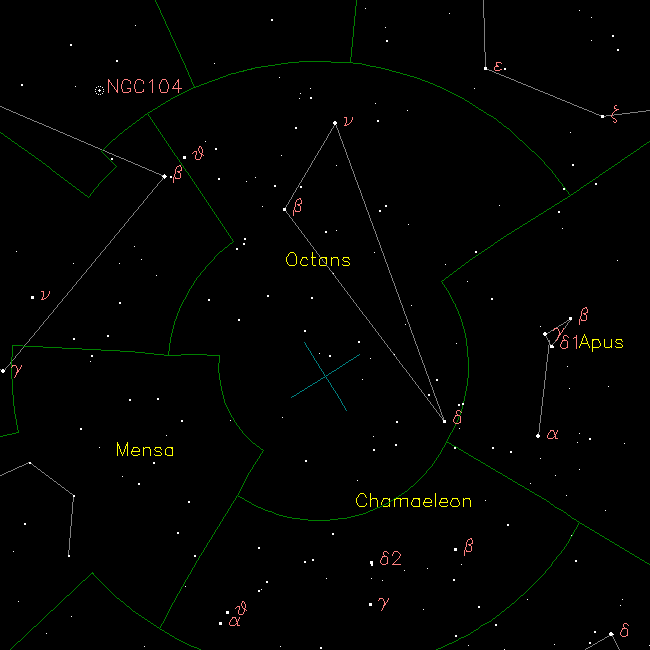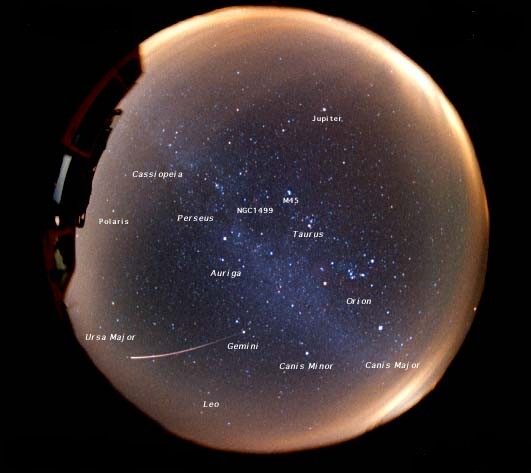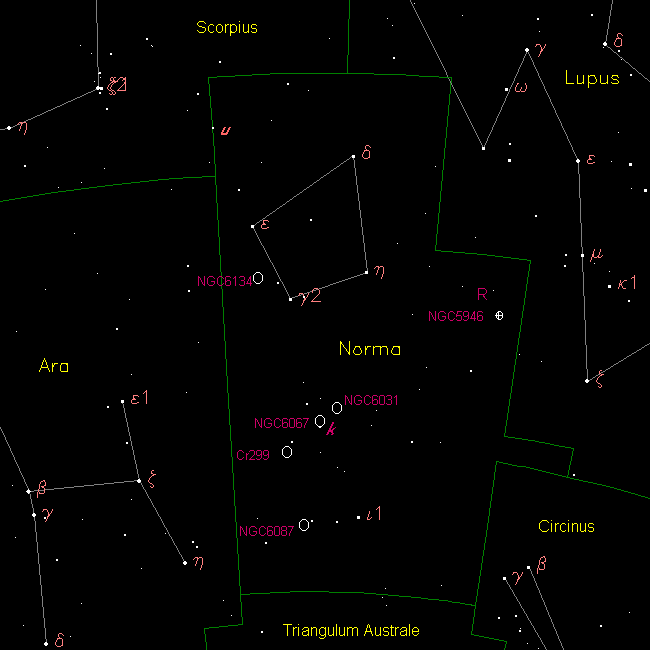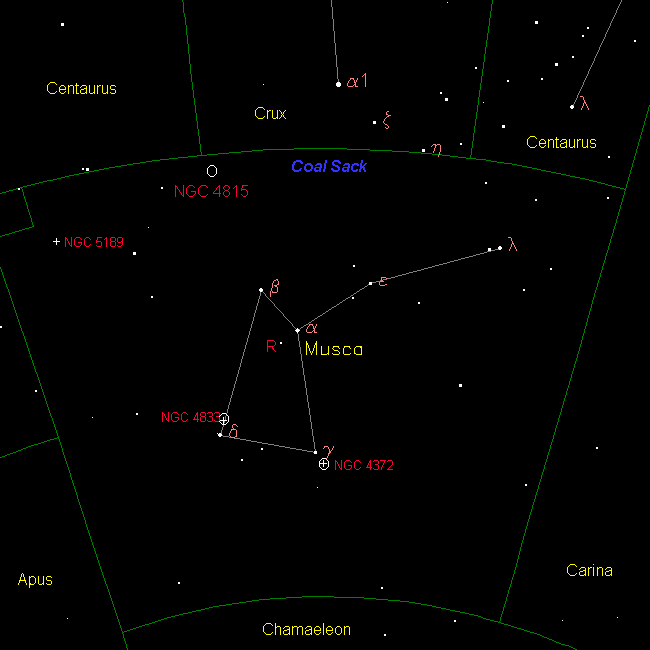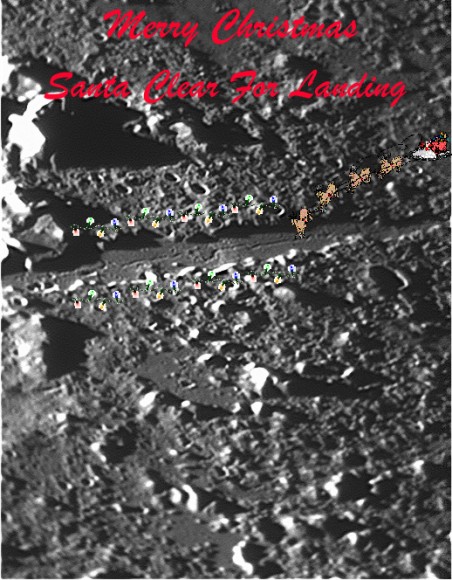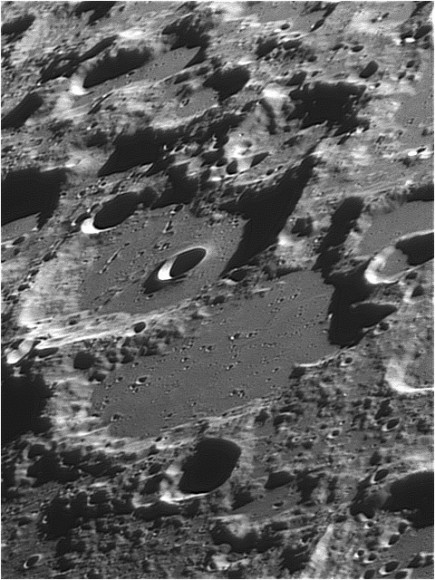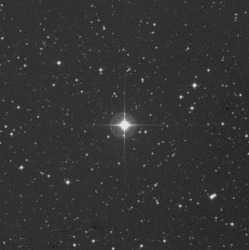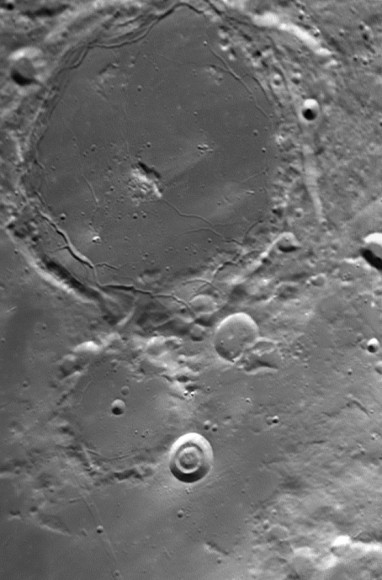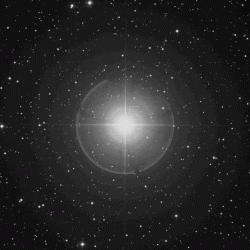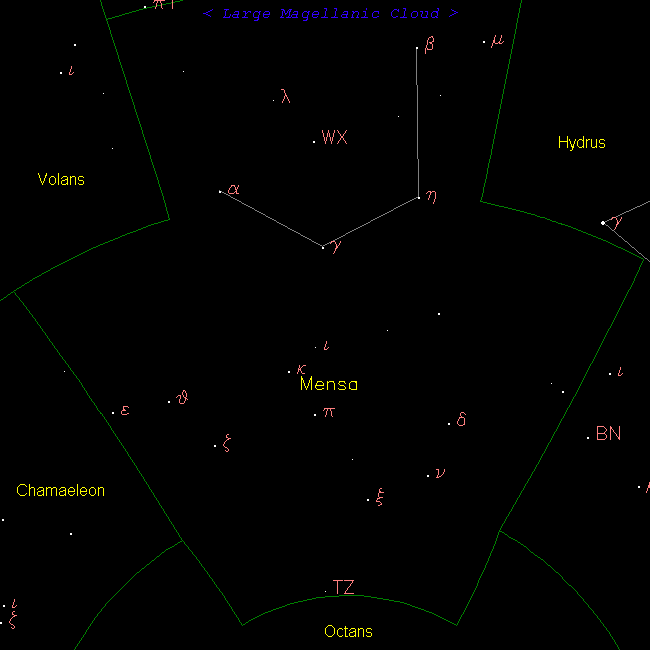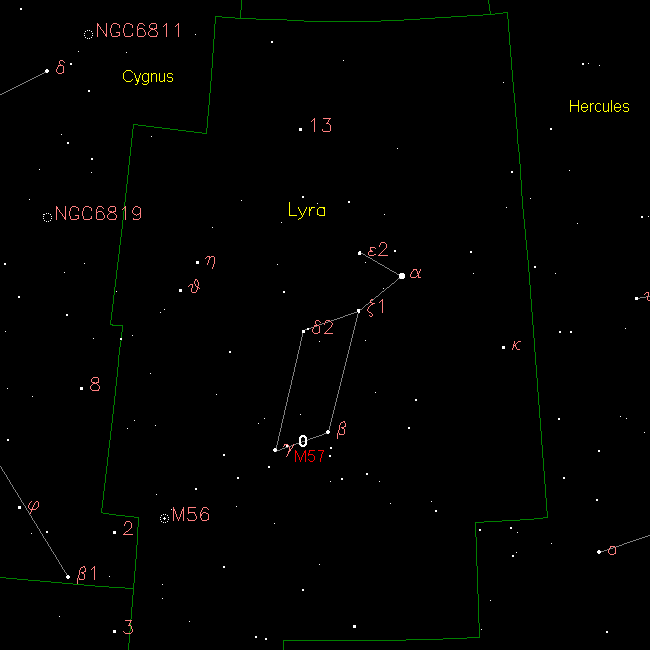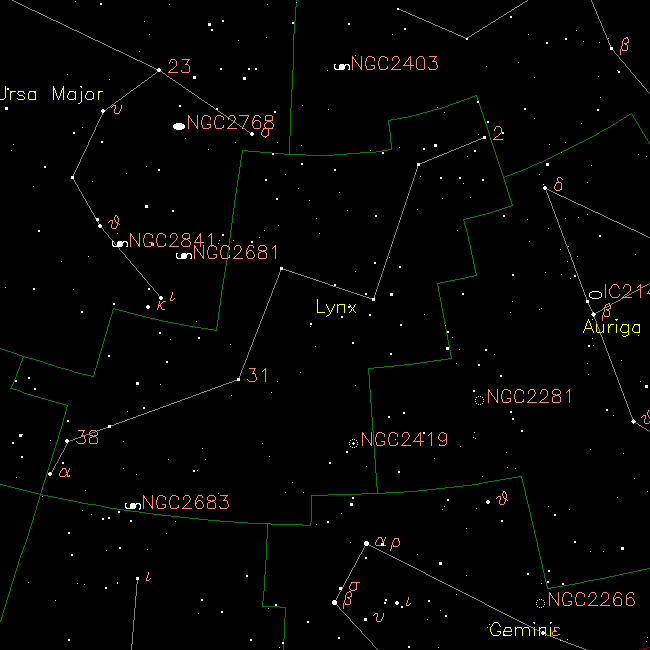[/caption]
Located north of the ecliptic plane, the constellation of Lyra is one of the original 48 constellations listed by Ptolemy, and remained as part of the 88 modern constellations recognized by the International Astronomical Union. Spanning only 286 square degrees of sky, Lyra ranks 52nd in size amongst the others, but contains the second brightest star in the northern hemisphere. Five main stars comprise its asterism and 25 Bayer Flamsteed designated stars are confined within its realm. Lyra is bordered by the constellations of Draco, Hercules, Vulpecula and Cygnus. It is visible to all viewers located at latitudes between +90° and ?40° and is best seen at culmination during the month of August.
There are two meteor showers associated with the constellation of Lyra. On or about April 22 of each year is the peak date of the annual Lyrid Meteor Shower. Its radiant – or where the meteors seem to originate – is around the bright star Vega. You can expect to see about 15 meteors per hour on the average when the constellation is at its highest on a dark night. They are bright, long-lasting meteors which leave long trails… the offspring of Comet Thatcher! The stream itself generally lasts through the beginning of May. By June 16, we return once again to hit another portion of the same stream, but with less force. The gravity of Jupiter and time has robbed this particular branch of the larger particles, so these meteors are much fainter. The fall rate also averages about 15 per hour maximum on a dark night – but the meteors are far fainter and tend to be more blue in color.
In mythology, Lyra is the “lyre”… a sort of hand-held harp. According to ancient Greeks, the messenger god Hermes created the lyre from the washed up body of a large tortoise shell which he covered with animal hide and antelope horns. He later gave it to Apollo as a present – who then presented it to his son Orpheus. There’s a wonderful quote by poet J.R. Lowell: “So there it lay, through wet and dry… As empty as the last new sonnet, Till by and by came Mercury, And, having mused upon it, ‘Why, here,’ cried he, ‘the thing of things In shape, material, and dimension! Give it but strings, and, lo, it sings, A wonderful invention!’ When Orpheus’ wife died, he was so grief stricken, he threw his harp into the Milky Way, wishing never to see it again. As legend has it, Apollo sent an eagle to retrieve it and set it among the stars. That is why you will also see it often depicted with wings as well. And so, the Lyre became part of the sky and it doesn’t take a whole lot of imagination to see its shape in the stars!
Now, let’s start our binocular tour of Lyra with its brightest star – Alpha – the “a” symbol on our map. Best known as Vega, it measures up as the second brightest star in the northern celestial hemisphere and the fifth brightest star in the night sky. Located 25.3 light years from Earth, this massively luminous A-type star is a suspected Delta-Scuti type variable star and its the first to have its spectrum photographed. Historically, Vega served as the northern pole star at about 12,000 BCE and will do so again at around 14,000 CE. Compared to our Sun, Vega is a youngster – with an unusually low abundance of the elements with a higher atomic number than that of helium. It’s also a rapid rotator – spinning completely on its axis in about 12 hours. So fast that the radius of the equator is 23% larger than the polar radius! Another thing Vega does have is an excess of infra-red radiation. What’s the cause? Possibly a circumstellar disc. Detections of irregularities in the disc means there’s a distinct chance of a planet the size of Jupiter orbiting there! I wonder how fast it orbits?
Keep your binoculars in hand and take a look at Beta Lyrae – the “B” symbol on our map. Now here’s a trick star system if there ever was one! Located 882 light-years from our solar system and named Sheliak, the “Tortoise” is very definitely a binary star – but not just any binary star. Sheliak is an eclipsing binary star. And not just any eclipsing binary star, but an eclipsing contact binary star system made up of a blue-white dwarf (B7V) star and a white main sequence (A8V) star. The two stars are close enough that material from the photosphere of each is pulled towards the other, drawing the stars into an ellipsoid shape. Beta Lyrae is the prototype for this class of eclipsing binaries, whose components are so close together that they deform by their mutual gravitation! In a period of period of 12.9075 days you’ll see this star swing drop from magnitude 3.4 to magnitude 4.6 – and it’s very noticeable. While you’ll never split the AB pair, you can very easily pick out the 7th magnitude C component with just your binoculars!
Don’t loose the binoculars yet. Head up to Delta 1 and Delta 2 – the figure “82” on our map. While the Delta pair is strictly an optical double star – this blue white and red pair of giant stars is very pleasing in binoculars. Slightly brighter, blue/white Delta 1 is located about 900 light years away and reddish Delta 2 is only about 720. Most of the time they are only separated by just a few tenths of a magnitude in brightness – but watch Delta 2 – because it is also a variable star and can become twice as dim! Did you happen to notice the pair is in a very stellar field? Good reason. Delta 1 and 2 are part of an open star cluster known as Stephenson 1.
Ready to have a look at Epsilon 2, the backwards “3” on our map? This is the famous “Double Double”. In binoculars you will see what appears to be a nice, white double star – but put a telescope at high magnification on it and watch what happens. Both stars will resolve into binary stars! The Epsilon Lyrae pair is one of the most observed multiple star systems in the heavens and the 162 light year distant mates make for a great time in just about any telescope – even in the most light polluted skies. Not only is each pair of stars physically connected to each other – but both pairs of stars are gravitationally bound – requiring over 12 centuries to complete their orbits. Are they close? You bet. If you have to wait for a moment of stability for them to cut themselves apart, then consider they’re only separated by about 0.16 of a light year!
And now for “Lucky 13″…
You can use binoculars, because star 13 is the infamous R Lyra – a proto-type variable star. Even though R is 350 light years away, its the brightest true (intrinsic) variable in the entire constellation. Sure, Beta looks brighter – but its changes come about because of eclipses – not because of internal processes. Inside of star 13 some mighty big changes are happening. Having progressed in its stellar evolution, this class M5 red giant star is also a semi-regular variable known as an SRb star – or a low-level, long period pulsating variable like Mira. Its changes are very noticeable, too… flipping between magnitude 3.9 and 5.0 over a 46 day period. Yes, it’s dying. And not a pretty death, either. Its mass is uncertain… It expands and contracts… its stellar temperature ranges from 3175 Kelvin to 3750 Kelvin… it has a dead carbon-oxygen core surrounded by fusing shells of helium… Apparently being star 13 isn’t so lucky!
Ready to get Messier? The go directly between Gamma and Beta Lyrae to grab the “Ring”… The only and only planetary nebula – M57. Discovered by French astronomer Antoine Darquier in 1779, the Ring Nebula was cataloged later that year by Charles Messier as M57 (RA 18 53 35 Dec +33 01 45). In binoculars the Ring will appear as slightly larger than a star, yet it cannot be focused to a sharp point. To a modest telescope at even low power, Messier 57 turns into a glowing donut against a wonderful stellar backdrop. The accepted distance to this unusual structure is about 1,400 light-years, and how you see the Ring on any given night is highly dependent on conditions. As aperture and power increase, so do details, and it is not impossible to see braiding in the nebula’s structure with scopes as small as 8″ on a fine night, or to pick up the star caught on the edge in even smaller apertures. Like all planetary nebulae, seeing the central star is considered the ultimate achievement in viewing. The central itself is a peculiar bluish dwarf which gives off a continuous spectrum, and might very well be a variable. At times, this shy, near 15th magnitude star can be seen with ease with a 12.5″ telescope, yet be elusive to even 31” in aperture weeks later. No matter what details you may see, reach for the “Ring” tonight. You’ll be glad you did.
More? Then hang on and let’s go globular cluster hunting as we capture Messier 56! Located roughly midway between Beta Cygni and Gamma Lyrae (RA 19 15 35.50 Dec +30 11 04.2), this class X globular was discovered by Charles Messier in 1779 on the same night he discovered a comet, and was later resolved by Herschel. At magnitude 8 and small in size, it’s a tough call for a beginner with binoculars, but is a very fine telescopic object. With a general distance of 33,000 light-years, this globular resolves well with larger scopes, but doesn’t show as much more than a faint, round area with small aperture. However, the beauty of the chains of stars in the field makes it quite worth the visit!
While you’re there, look carefully: M56 is one of the very few objects for which the photometry of its variable stars was studied strictly with amateur telescopes. While one bright variable had been known previously, up to a dozen more have recently been discovered. Of those, six had their variability periods determined using CCD photography and telescopes just like yours!
For a big telescope challenge, try your luck with NGC 6702 (RA 18:47.0 Dec +45:42). This magnitude 12, this small, faint elliptical galaxy was home to a supernovae event in 2002 and has a high evolved and highly studied globular cluster system. For a slightly brighter galaxy, look up very nearby NGC 6703 (RA 18:47.3 Dec +45:33) to the southeast. Also an elliptical galaxy, but a full magnitude brighter and slightly larger, you’ll pick out a more round signature in this one. Studies have found a dust lane in the center of NGC 6702 indicating a recent gaseous galaxy merger event meaning this pair are truly and interacting set.
Sources: SEDS, Wikipedia
Chart courtesy of Your Sky.

